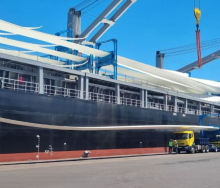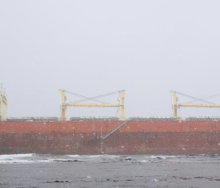Residents of Komatipoort could legally pursue transporters for tipping soot out of ore trucks carrying coal and manganese to the Port of Maputo.
Cobus Botha, who heads up the border town’s agricultural association, has on various occasions complained that tippers are often seen by the side of the highway, emptying potentially hazardous soot from their trailer buckets.
It is understood that a depot in the town on South Africa’s N4 corridor crossing into Mozambique, said by some community leaders to be an illegal facility, is responsible for committing most of the pollution.
Ore carriers can also often be seen stopping on agricultural services roads, dumping black dust directly adjacent to plantations.
Besides Botha, other sources from the community, whose economy consists of citrus and sugar cane farming, said the soot posed an environmental health hazard as it could leach into groundwater.
The town’s tourism industry has also expressed fears that soot run-off could compromise the area’s river ecology, which comprises the Crocodile flowing from the north of the Kruger National Park into the Komati directly south of the community.
But apart from the obvious hazards that potentially toxic soot ending up in water entails for human and animal consumption, it is the occupational safety obligations of road freight operators that should really be explored.
Speaking at Webber Wentzel’s annual Mining Sector Round-Up, employment law specialist Kate Collier recommended that people familiarise themselves with relevant obligations applying to logistical service providers under the Occupational Health and Safety (OHS) Act.
She said although the Mine Health and Safety Act did not apply once minerals had been extracted from the ground, “it doesn’t mean there is no liability for the person under whose control it remains”.
From a workplace safety aspect, transporters could be held liable for exposing their drivers to potential risk, Collier said.
“There would also be ongoing liability and obligation in respect of the environmental controls associated with that.”
It includes commercial liability that service providers have to their clients regulated by related contracts.
“The question as to which Act applies,” Collier said, “is really a question as to who carries the obligation of the safety of the employees on work-related tasks that are associated with the transport of these minerals.”
Most likely it would be the OHS Act, she said, which stipulated that the employer of the people operating transport and logistics facilities would have agreed to take practical measures to ensure their employees were not exposed to harm.
Important for the residents of Komatipoort, is that section nine of the Act states that employers have a health and safety responsibility to the wider community.
A separate search of the Act says: “Every employer (including the State/Government) shall conduct his undertaking in such a way as to ensure, as far as is reasonably practicable, that persons other than those in his employment who may be directly affected by his activities are not thereby exposed to hazards to their health or safety.”
Collier’s partner at Webber Wentzel, who heads up the firm’s Environmental Law department, Garyn Rapson, said whereas the OHS Act was usually applied within the confines of a commercial concern, environmental law usually kicked in for matters on the outside.
“The community has multiple legal avenues to explore and go directly to environmental management inspectorates to lodge a complaint,” he said.
He said changes to the law last year also made it possible for residents to directly approach their municipal managers with environmental concerns.













